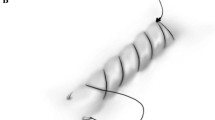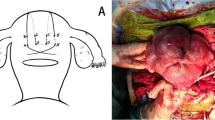Abstract
Purpose
This study is performed to evaluate and compare the efficacy of cervical-lifting suture and lower B-Lynch suture in different severity of placenta previa associated with lower uterine segment bleeding.
Methods
We evaluated the effectiveness of cervical-lifting suture (n = 51) and lower B-Lynch suture (n = 137) in stopping the bleeding from lower uterine segment. Additionally, we used different statistical methods, including overall analysis, subgroup analysis and approximate randomization analysis, to evaluate the efficacy of the two assessments.
Results
The medical records of these 188 participants were extracted and all of the patients were followed up for six weeks. The majority of patients were multipara and complicated with previous cesarean delivery and abnormal adherent placenta. The median intraoperative blood loss and the median amount of red blood cell transfusion were lower in the cervical-lifting suture group in comparison to the lower B-Lynch suture group.
Conclusion
Our study provides evidence that cervical-lifting suture has less intraoperative blood loss and red blood cell transfusion for controlling lower uterine segment bleeding in placenta previa.



Similar content being viewed by others
References
Solheim KN, Esakoff TF, Little SE, Cheng YW, Sparks TN, Caughey AB (2011) The effect of cesarean delivery rates on the future incidence of placenta previa, placenta accreta, and maternal mortality. J Maternal-fetal Neonatal 24(11):1341–1346. https://doi.org/10.3109/14767058.2011.553695
Li HT, Luo S, Trasande L, Hellerstein S, Kang C, Li JX, Zhang Y, Liu JM, Blustein J (2017) Geographic variations and temporal trends in cesarean delivery rates in China, 2008–2014. JAMA 317(1):69–76. https://doi.org/10.1001/jama.2016.18663
Betran AP, Ye J, Moller AB, Zhang J, Gulmezoglu AM, Torloni MR (2016) The increasing trend in caesarean section rates: global, regional and national estimates: 1990–2014. PLoS ONE 11(2):e0148343. https://doi.org/10.1371/journal.pone.0148343
Luke RK, Sharpe JW, Greene RR (1966) Placenta accreta: the adherent or invasive placenta. Am J Obstet Gynecol 95(5):660–668. https://doi.org/10.1016/s0002-9378(16)34741-x
Mullen C, Battarbee AN, Ernst LM, Peaceman AM (2019) Occult placenta accreta: risk factors, adverse obstetrical outcomes, and recurrence in subsequent pregnancies. Am J Perinatol 36(5):472–475. https://doi.org/10.1055/s-0038-1669440
Jauniaux E, Alfirevic Z, Bhide AG, Belfort MA, Burton GJ, Collins SL, Dornan S, Jurkovic D, Kayem G, Kingdom J, Silver R, Sentilhes L (2019) Placenta praevia and placenta accreta: diagnosis and management: green-top guideline No. 27a. BJOG 126(1):e1–e48. https://doi.org/10.1111/1471-0528.15306
Allen L, Jauniaux E, Hobson S, Papillon-Smith J, Belfort MA (2018) FIGO consensus guidelines on placenta accreta spectrum disorders: nonconservative surgical management. Int J Gynaecol Obst 140(3):281–290. https://doi.org/10.1002/ijgo.12409
Li GT, Li XF, Wu B, Li G (2016) Longitudinal parallel compression suture to control postopartum hemorrhage due to placenta previa and accrete. Taiwan J Obstet Gynecol 55(2):193–197. https://doi.org/10.1016/j.tjog.2016.02.008
Meng Y, Wu P, Deng D, Wu J, Lin X, Beejadhursing R, Zha Y, Qiao F, Feng L, Liu H, Zeng W (2017) Multifaceted spiral suture: a hemostatic technique in managing placenta praevia or accrete: a retrospective study. Medicine 96(49):e9101. https://doi.org/10.1097/md.0000000000009101
Mohamed MA (2017) Parallel vertical compression sutures to control bleeding in cases of placenta previa and accreta. J Maternal-fetal Neonatal Med. https://doi.org/10.1080/14767058.2017.1387895
Acar A, Ercan F, Pekin A, Elci Atilgan A, Sayal HB, Balci O, Gorkemli H (2018) Conservative management of placental invasion anomalies with an intracavitary suture technique. Int J Gynaecol Obstet 143(2):184–190. https://doi.org/10.1002/ijgo.12593
Chen YS, Zhao YY, Zhang Y, Wang Y, Zhong YW, Zhang AQ (2018) Application of cervical lifting suture in hemostasis of placenta previa with increta and percreta. Zhonghua fu chan ke za zhi 53(7):459–463. https://doi.org/10.3760/cma.j.issn.0529-567x.2018.07.004
Shih JC, Liu KL, Kang J, Yang JH, Lin MW, Yu CU (2018) 'Nausicaa' compression suture: a simple and effective alternative to hysterectomy in placenta accreta spectrum and other causes of severe postpartum haemorrhage. BJOG. https://doi.org/10.1111/1471-0528.15410
Bl C, Coker A, Lawal AH, Abu J, Cowen MJ (1997) The B-Lynch surgical technique for the control of massive postpartum haemorrhage: an alternative to hysterectomy? Five cases reported. Br J Obstet Gynaecol 104(3):372–375
Dedes I, Ziogas V (2008) Circular isthmic-cervical sutures can be an alternative method to control peripartum haemorrhage during caesarean section for placenta praevia accreta. Arch Gynecol Obstet 278(6):555–557. https://doi.org/10.1007/s00404-008-0646-z
Li GT, Li GR, Li XF, Wu BP (2016) Funnel compression suture: a conservative procedure to control postpartum bleeding from the lower uterine segment. BJOG 123(8):1380–1385. https://doi.org/10.1111/1471-0528.13685
Cho JH, Jun HS, Lee CN (2000) Hemostatic suturing technique for uterine bleeding during cesarean delivery. Obstet Gynecol 96(1):129–131
Hayman RG, Arulkumaran S, Steer PJ (2002) Uterine compression sutures: surgical management of postpartum hemorrhage. Obstet Gynecol 99(3):502–506
Palacios-Jaraquemada JM (2011) Efficacy of surgical techniques to control obstetric hemorrhage: analysis of 539 cases. Acta Obstet Gynecol Scand 90(9):1036–1042. https://doi.org/10.1111/j.1600-0412.2011.01176.x
Chandraharan E, Rao S, Belli AM, Arulkumaran S (2012) The Triple-P procedure as a conservative surgical alternative to peripartum hysterectomy for placenta percreta. Int J Gynaecol Obstetrics 117(2):191–194. https://doi.org/10.1016/j.ijgo.2011.12.005
Shazly SA, Badee AY, Ali MK (2012) The use of multiple 8 compression suturing as a novel procedure to preserve fertility in patients with placenta accreta: case series. Aust N Z J Obstet Gynaecol 52(4):395–399. https://doi.org/10.1111/j.1479-828X.2012.01449.x
Ratiu AC, Crisan DC (2018) A prospective evaluation and management of different types of placenta praevia using parallel vertical compression suture to preserve uterus. Medicine 97(46):e13253. https://doi.org/10.1097/md.0000000000013253
Jauniaux E, Bhide A (2017) Prenatal ultrasound diagnosis and outcome of placenta previa accreta after cesarean delivery: a systematic review and meta-analysis. Am J Obstet Gynecol 217(1):27–36. https://doi.org/10.1016/j.ajog.2017.02.050
Lodhi W, Golara M, Karangaokar V, Yoong W (2012) Uterine necrosis following application of combined uterine compression suture with intrauterine balloon tamponade. J Obstet Gynaecol 32(1):30–31. https://doi.org/10.3109/01443615.2011.614972
Ploteau S, Renou M, Lopes P (2012) Uterine necrosis and pyometra following surgical hemostatic Cho suture for postpartum haemorrhage: two cases. Eur J Obstet Gynecol Reprod Biol 161(2):233–234. https://doi.org/10.1016/j.ejogrb.2011.12.015
Rashmi MD, Lokeshchandra HC, Chaitra TM (2013) Uteroumbilical fistula with myometrial necrosis following compression suture for atonic PPH: a rare case. Arch Gynecol Obstet 287(5):1045–1046. https://doi.org/10.1007/s00404-012-2606-x
Simpson AN, Pittini R, Hui D, Morgan A, Kroft J (2015) Uterine full thickness multifocal dehiscence associated with a history of cho uterine compression sutures. JOGC 37(7):583. https://doi.org/10.1016/s1701-2163(15)30192-4
Benkirane S, Saadi H, Serji B, Mimouni A (2017) Uterine necrosis following a combination of uterine compression sutures and vascular ligation during a postpartum hemorrhage: a case report. Int J Surg Case Rep 38:5–7. https://doi.org/10.1016/j.ijscr.2017.07.005
Chikazawa K, Imai K, Liangcheng W, Sasaki S, Horiuchi I, Kuwata T, Takagi K (2018) Detection of Asherman's syndrome after conservative management of placenta accreta: a case report. J Med Case Rep 12(1):344. https://doi.org/10.1186/s13256-018-1869-7
Mallappa Saroja CS, Nankani A, El-Hamamy E (2010) Uterine compression sutures, an update: review of efficacy, safety and complications of B-Lynch suture and other uterine compression techniques for postpartum haemorrhage. Arch Gynecol Obstet 281(4):581–588. https://doi.org/10.1007/s00404-009-1249-z
Matsubara S, Yano H, Ohkuchi A, Kuwata T, Usui R, Suzuki M (2013) Uterine compression sutures for postpartum hemorrhage: an overview. Acta Obstet Gynecol Scand 92(4):378–385. https://doi.org/10.1111/aogs.12077
Mohamed MA, Mohammed AH (2019) Parallel vertical compression sutures to control bleeding in cases of placenta previa and accreta. J Maternal-fetal Neonatal Med 32(4):641–645. https://doi.org/10.1080/14767058.2017.1387895
Vijayasree M (2016) Efficacy of prophylactic B-Lynch suture during lower segment caesarian section in high risk patients for atonic postpartum haemorrhage. KUMJ 14(53):9–12
Acknowledgements
We would like to thank the academic support of Science and Technology of North Sichuan Medical College.
Funding
No funding source was involved.
Author information
Authors and Affiliations
Contributions
YG: data analysis and manuscript writing; ZC: data collection; QS: project development.
Corresponding author
Ethics declarations
Conflict of interest
None declared.
Informed consent
The informed consent is not applicable. But the study protocol had been approved by the Ethics Committee of Science and Technology of North Sichuan Medical College.
Additional information
Publisher's Note
Springer Nature remains neutral with regard to jurisdictional claims in published maps and institutional affiliations.
Rights and permissions
About this article
Cite this article
Gan, Y., Chen, Z. & Shi, Q. The efficacy between cervical-lifting suture and lower B-Lynch suture in placenta previa: a retrospective cohort-study. Arch Gynecol Obstet 302, 365–376 (2020). https://doi.org/10.1007/s00404-020-05625-z
Received:
Accepted:
Published:
Issue Date:
DOI: https://doi.org/10.1007/s00404-020-05625-z




